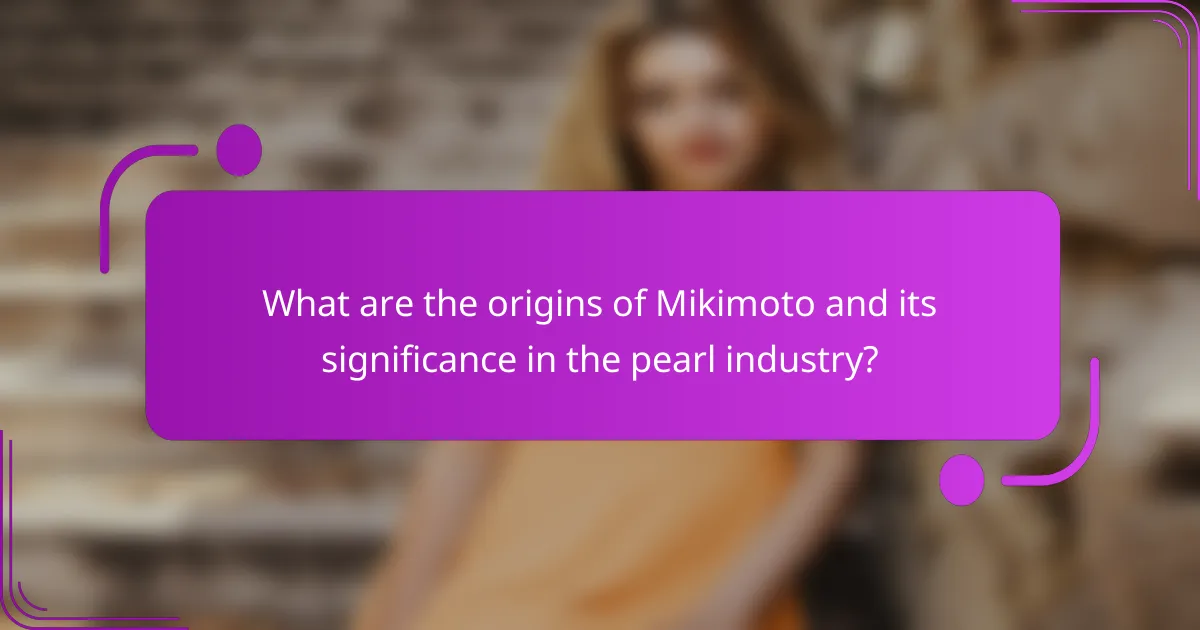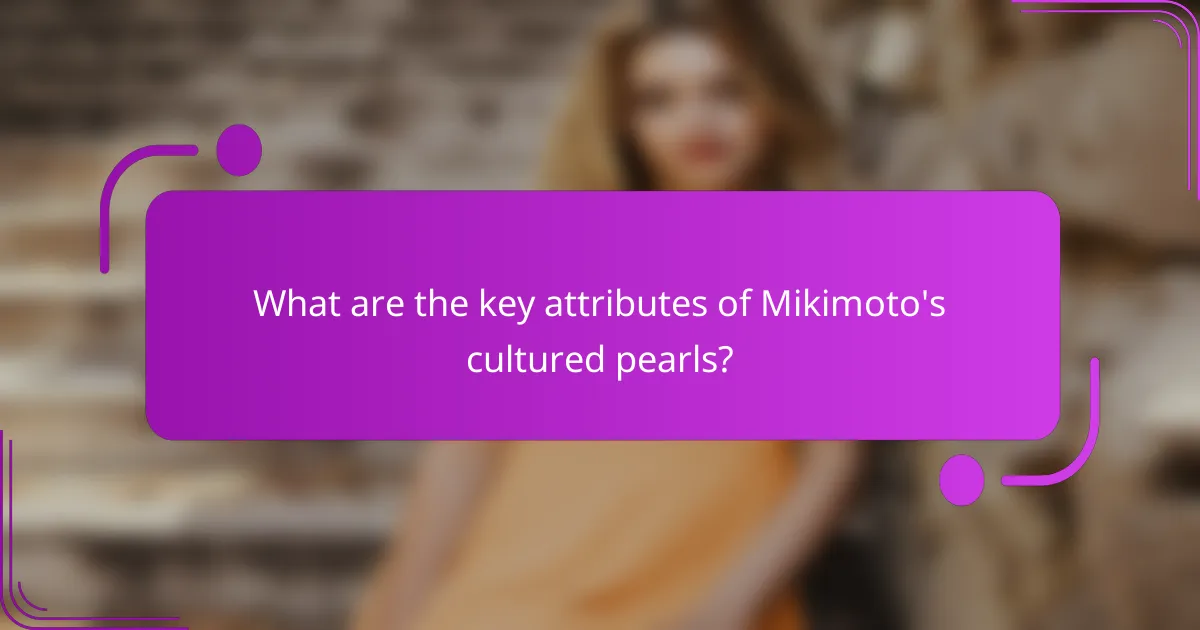Mikimoto is a prestigious brand founded by Kokichi Mikimoto in Japan in 1893, recognized for creating the first cultured pearls through innovative cultivation techniques. The article explores the origins of Mikimoto, detailing how the process of implanting a nucleus into oysters transformed the pearl industry and made high-quality pearls accessible to a wider audience. It highlights Mikimoto’s commitment to craftsmanship, ensuring pearls are known for their exceptional luster, round shape, and consistent quality. Additionally, the article provides care guidelines for maintaining the beauty and longevity of Mikimoto pearls, emphasizing the importance of proper cleaning, storage, and professional inspection. Overall, it underscores Mikimoto’s global influence and enduring reputation in the luxury pearl market.

What are the origins of Mikimoto and its significance in the pearl industry?
Mikimoto originated in Japan in the late 19th century. Founded by Kokichi Mikimoto in 1893, the brand is renowned for creating the first cultured pearls. Mikimoto’s innovative techniques revolutionized the pearl industry. He successfully cultivated pearls by implanting a nucleus into an oyster. This process allowed for the mass production of pearls, making them accessible to a broader audience. Mikimoto’s contributions elevated the status of pearls in fashion and jewelry. The brand remains synonymous with quality and luxury in the pearl market. Today, Mikimoto is recognized globally for its craftsmanship and influence in pearl cultivation.
How did Mikimoto pioneer the cultivation of pearls?
Mikimoto pioneered the cultivation of pearls by developing the first successful method for producing cultured pearls in the late 19th century. He introduced the technique of inserting a small bead into an oyster to stimulate pearl formation. This innovative approach allowed for controlled pearl production, ensuring quality and consistency. Mikimoto’s experiments began in 1893 and culminated in the first commercial harvest in 1896. His work established the foundation for the modern pearl industry. Today, Mikimoto is recognized as the “Father of Cultured Pearls.” His techniques revolutionized pearl farming and made pearls accessible to a broader market.
What challenges did Mikimoto face during the development of cultured pearls?
Mikimoto faced significant challenges in developing cultured pearls. He struggled with the initial skepticism of the pearl industry. Many believed that cultured pearls could not rival natural pearls in quality. Additionally, he encountered technical difficulties in the implantation process. Ensuring a consistent and successful nucleation required extensive experimentation. There was also a lack of understanding about oyster biology at that time. This made it difficult to cultivate the oysters effectively. Furthermore, Mikimoto faced financial challenges while funding his research and development efforts. Despite these obstacles, he persevered and eventually succeeded in creating high-quality cultured pearls.
How did Mikimoto’s early experiments shape the future of pearl cultivation?
Mikimoto’s early experiments established the foundation for modern pearl cultivation. He developed techniques for implanting a nucleus into oysters to stimulate pearl production. This innovation allowed for consistent and predictable results in pearl farming. His successful cultivation of pearls in the late 19th century revolutionized the industry. Mikimoto’s methods increased the availability of pearls, making them accessible to a broader audience. The techniques he pioneered are still used today in pearl farming worldwide. His work also set standards for quality and authenticity in the pearl market. Ultimately, Mikimoto’s contributions transformed pearls from a luxury item into a commercially viable product.
What role did craftsmanship play in the creation of Mikimoto pearls?
Craftsmanship played a crucial role in the creation of Mikimoto pearls. The founder, Kokichi Mikimoto, emphasized meticulous techniques in pearl cultivation. He developed the process of implanting a nucleus into an oyster to stimulate pearl formation. This innovative method required skilled artisans to ensure precision and consistency. Each step, from oyster selection to harvesting, demanded expert knowledge. Mikimoto’s commitment to quality craftsmanship established a standard in the pearl industry. His techniques resulted in the production of lustrous, high-quality cultured pearls. The emphasis on craftsmanship contributed to Mikimoto’s global reputation and influence in luxury jewelry.
What techniques are unique to Mikimoto’s pearl crafting process?
Mikimoto’s pearl crafting process is distinguished by its pioneering technique of nucleation. This method involves implanting a small bead into an oyster to stimulate pearl formation. Mikimoto also employs meticulous harvesting practices, ensuring optimal growth and quality. The brand’s commitment to quality control is evident in their rigorous selection of oysters. Additionally, Mikimoto’s unique approach includes a focus on the roundness and luster of pearls. Their craftsmanship combines traditional techniques with innovative methods. This blend has set a standard in the cultured pearl industry. Mikimoto’s legacy is built on these unique techniques, influencing global pearl production.
How does Mikimoto ensure quality in its pearl production?
Mikimoto ensures quality in its pearl production through meticulous cultivation and strict quality control processes. The company employs a unique method of pearl farming that involves careful selection of oysters. Each oyster is nurtured in a controlled environment to promote optimal growth. Mikimoto also utilizes advanced techniques for grafting, which enhances the quality of the pearls produced. The pearls undergo rigorous inspection at multiple stages of production. This includes evaluating luster, surface quality, and shape. Mikimoto’s commitment to quality is further demonstrated by its use of sustainable practices in pearl cultivation. These measures ensure that only the finest pearls reach the market.
How has Mikimoto influenced global perceptions of cultured pearls?
Mikimoto has significantly influenced global perceptions of cultured pearls by establishing their luxury status. Founded by Kokichi Mikimoto in 1893, the brand was the first to successfully cultivate pearls. This innovation changed how people viewed pearls, shifting from natural to cultured as a viable option. Mikimoto’s marketing emphasized quality and craftsmanship, which elevated consumer expectations. The brand’s iconic designs and high-profile endorsements further solidified cultured pearls as a symbol of elegance. Events such as the 1913 Paris Exhibition showcased Mikimoto’s pearls to an international audience. This exposure helped transform cultured pearls into a desirable luxury item worldwide. Today, Mikimoto remains synonymous with premium cultured pearls, influencing perceptions across cultures.
What marketing strategies did Mikimoto employ to promote cultured pearls worldwide?
Mikimoto employed several marketing strategies to promote cultured pearls globally. The brand focused on high-quality craftsmanship to establish a premium image. They utilized celebrity endorsements to enhance brand visibility. Mikimoto also engaged in strategic partnerships with luxury retailers. Their marketing campaigns highlighted the uniqueness of cultured pearls. The company organized exclusive events to showcase their products. They emphasized the heritage and artistry behind pearl cultivation. Mikimoto’s branding efforts created a strong emotional connection with consumers. These strategies helped position Mikimoto as a leader in the cultured pearl market.
How has Mikimoto’s branding contributed to the luxury status of pearls?
Mikimoto’s branding has significantly elevated the luxury status of pearls. The brand is synonymous with high-quality cultured pearls. Founded by Kokichi Mikimoto in 1893, it pioneered the cultivation of pearls. Mikimoto’s meticulous craftsmanship ensured each pearl met strict quality standards. The brand’s marketing emphasized elegance and sophistication. Iconic designs showcased pearls as symbols of luxury. Collaborations with renowned designers further enhanced its prestige. Mikimoto’s commitment to innovation maintained its leadership in the pearl industry. This strategic branding positioned pearls as essential luxury items globally.

What are the key attributes of Mikimoto’s cultured pearls?
Mikimoto’s cultured pearls are renowned for their exceptional luster, round shape, and high quality. These pearls are cultivated using a unique method developed by Kokichi Mikimoto in the late 19th century. The cultivation process involves inserting a nucleus into an oyster, which then secretes nacre around it. This results in pearls that exhibit a brilliant sheen and a smooth surface. Mikimoto pearls are also known for their consistent size and color. The brand maintains strict quality control standards, ensuring that only the finest pearls are sold. Mikimoto’s commitment to craftsmanship has established its reputation as a leader in the pearl industry.
What types of cultured pearls does Mikimoto offer?
Mikimoto offers several types of cultured pearls, including Akoya pearls, South Sea pearls, and Tahitian pearls. Akoya pearls are known for their high luster and round shape. They are primarily produced in Japan and are often used in classic pearl jewelry. South Sea pearls are larger and come in shades of white and gold. They are cultivated in Australia and the Philippines. Tahitian pearls are unique for their dark colors, which range from black to green and blue. They originate from French Polynesia. Each type of pearl has distinct characteristics that contribute to Mikimoto’s reputation for quality and luxury in pearl jewelry.
How do the different types of Mikimoto pearls vary in appearance and quality?
Mikimoto pearls vary in appearance and quality based on their type. The main types include Akoya, South Sea, and Tahitian pearls. Akoya pearls are typically smaller, ranging from 6mm to 9mm, and feature a high luster with a smooth surface. They often display white or cream colors with rose or silver overtones.
South Sea pearls are larger, generally between 9mm and 20mm, and are known for their thick nacre and rich colors, including gold and white. Their surface quality is often superior due to the larger oysters used in their cultivation.
Tahitian pearls are unique for their dark colors, which can range from black to green and blue hues. They are also larger, usually between 8mm and 18mm, and have a distinctive, often irregular shape.
In terms of quality, Mikimoto pearls are graded based on luster, surface quality, shape, and size. Higher quality pearls exhibit brilliant luster and minimal blemishes. The grading system is crucial for determining the value and desirability of each type.
What factors influence the pricing of Mikimoto pearls?
The pricing of Mikimoto pearls is influenced by several key factors. These factors include the size of the pearls, which typically range from 6mm to 20mm. The quality of the nacre, or the outer layer, also significantly affects pricing, with thicker nacre resulting in higher value. The luster of the pearls, which refers to their shine and reflective qualities, plays a crucial role in determining price. Additionally, the shape of the pearls matters; round pearls are generally more valuable than baroque or irregular shapes. The color is another important factor, with rare colors commanding higher prices. Lastly, the origin of the pearls contributes to their value, as Mikimoto pearls are known for their exceptional craftsmanship and heritage. These attributes collectively establish the market value of Mikimoto pearls.
What are the benefits of choosing Mikimoto pearls?
Mikimoto pearls offer exceptional quality and beauty. They are renowned for their luster and surface quality. Mikimoto is credited with creating the first cultured pearls in 1893. This innovation set a standard for pearl cultivation worldwide. The brand ensures strict quality control in its production process. Each pearl undergoes meticulous grading for size, shape, and color. Mikimoto pearls are often considered a symbol of luxury and elegance. Their heritage and craftsmanship enhance their value in the jewelry market.
How do Mikimoto pearls compare to natural pearls in terms of value?
Mikimoto pearls generally have a lower market value compared to natural pearls. Natural pearls are rare, often fetching much higher prices due to their scarcity. Mikimoto pearls are cultured, produced in controlled environments, making them more accessible. The price of natural pearls can reach thousands to millions of dollars, depending on size and quality. In contrast, Mikimoto pearls typically range from a few hundred to several thousand dollars. The demand for natural pearls contributes to their higher valuation in the luxury market. Mikimoto pearls, while valued for their quality, do not carry the same rarity factor as natural pearls.
What guarantees does Mikimoto provide to consumers regarding pearl quality?
Mikimoto guarantees consumers high-quality pearls through stringent quality control measures. Each pearl undergoes a meticulous evaluation process. This includes assessing luster, surface quality, shape, and size. Mikimoto’s pearls are often graded based on these attributes. The brand also provides a certificate of authenticity with each purchase. This certificate confirms the pearl’s origin and quality. Mikimoto’s commitment to excellence has been recognized globally. The brand has maintained a reputation for premium cultured pearls since its inception in 1893.

How can consumers appreciate and care for Mikimoto pearls?
Consumers can appreciate and care for Mikimoto pearls by following specific guidelines. Regular cleaning is essential. Use a soft, lint-free cloth to wipe the pearls after wearing them. This removes oils and dirt that can accumulate. Store Mikimoto pearls in a soft pouch or a separate compartment. This prevents scratches and damage from other jewelry. Avoid exposing pearls to harsh chemicals. Products like perfumes and hairsprays can harm their luster.
Limit wearing them during activities that may cause physical stress. This includes exercising or swimming. A yearly professional inspection is also recommended. Experts can check for loose knots and overall condition. By following these care instructions, consumers can maintain the beauty and longevity of Mikimoto pearls.
What are the best practices for maintaining Mikimoto pearls?
To maintain Mikimoto pearls, clean them regularly with a soft, lint-free cloth. This prevents dirt and oils from building up. Avoid exposure to harsh chemicals, including perfumes and lotions. Store Mikimoto pearls in a soft pouch or a separate compartment to prevent scratching. Keep them away from direct sunlight and extreme temperatures. Have them restrung every few years to ensure their longevity. Regular maintenance preserves their luster and quality. Mikimoto pearls are delicate and require careful handling to maintain their beauty. Following these practices will help retain their value and appearance over time.
How should Mikimoto pearls be stored to ensure longevity?
Mikimoto pearls should be stored in a soft, breathable pouch or a lined jewelry box. This prevents scratching and damage from other jewelry. Avoid storing pearls in airtight containers, as they need moisture to maintain luster. Keep them away from direct sunlight and extreme temperatures, which can cause discoloration. Regularly clean them with a soft, damp cloth after wearing. This helps remove oils and dirt that can degrade the surface. Proper storage ensures the longevity and beauty of Mikimoto pearls.
What cleaning methods are recommended for Mikimoto pearls?
Mikimoto pearls should be cleaned gently with a soft, lint-free cloth. This method helps to remove dirt and oils without damaging the surface. It is recommended to avoid harsh chemicals and ultrasonic cleaners, as they can harm the pearls. Additionally, pearls should be wiped after wearing to maintain their luster. For deeper cleaning, a mild soap solution with water can be used, followed by thorough rinsing and drying with a soft cloth. These methods ensure the longevity and beauty of Mikimoto pearls.
What tips should consumers consider when purchasing Mikimoto pearls?
When purchasing Mikimoto pearls, consumers should prioritize authenticity. Verify that the pearls are genuine Mikimoto products by checking for the brand’s signature. Look for the Mikimoto logo, which is usually engraved on the clasp or the pearl itself. Evaluate the quality of the pearls by examining their luster, surface quality, and shape. High-quality Mikimoto pearls exhibit a deep, reflective surface and minimal blemishes. Consider the size of the pearls, as larger pearls typically command higher prices. Additionally, be aware of the type of necklace or jewelry setting, as this can affect overall value. Research the current market prices for Mikimoto pearls to ensure a fair purchase. Lastly, purchase from reputable retailers or directly from Mikimoto to avoid counterfeit products.
How can buyers authenticate Mikimoto pearls before purchase?
Buyers can authenticate Mikimoto pearls by checking for specific hallmarks and certificates. Authentic Mikimoto pearls are often accompanied by a certificate of authenticity from Mikimoto. This certificate includes details about the pearl’s origin and quality. Buyers should also look for the Mikimoto logo, usually engraved on the clasp or inside the jewelry piece. Additionally, genuine Mikimoto pearls have a high luster and a smooth surface. They should be free of blemishes and have a consistent shape. Buyers can also consult with a reputable jeweler for verification. This ensures that the pearls meet the high standards set by Mikimoto.
What should consumers look for in terms of quality when selecting Mikimoto pearls?
Consumers should look for luster, surface quality, shape, size, and nacre thickness when selecting Mikimoto pearls. Luster refers to the reflective quality of the pearl’s surface. High-quality Mikimoto pearls exhibit a deep, radiant shine. Surface quality should be free from blemishes and imperfections. The shape of the pearls should ideally be round, as this is considered the most desirable. Size varies, but larger pearls are typically more valuable. Nacre thickness affects durability and appearance; thicker nacre indicates better quality. These attributes are critical in determining the overall quality and value of Mikimoto pearls.
Mikimoto is the pioneering entity in the cultured pearl industry, founded by Kokichi Mikimoto in Japan in 1893. The article explores the origins of Mikimoto, detailing its groundbreaking techniques for pearl cultivation, which transformed the perception and accessibility of pearls in the luxury market. It discusses the challenges faced by Mikimoto, the role of craftsmanship in producing high-quality pearls, and the various types of Mikimoto pearls, including their unique attributes and pricing factors. Additionally, the article highlights Mikimoto’s influence on global perceptions of cultured pearls and provides insights on caring for and purchasing these luxury items.